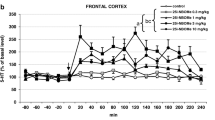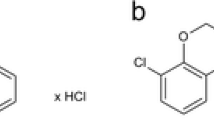Summary
The cholinomimetic activities of the antidepressant drug minaprine have been investigated, in vitro and in vivo, in rodents. Minaprine, and its metabolite SR 95070B [3-(2-morphohnoethylamino)-4-methyl-6-(2-hydroxyphenyl) pyridazine hydrochloride] selectively displaced [3H]-pirenzepine from its cortical and hippocampal binding sites, and only weakly inhibited the binding of [3H]-N-methylscopolamine in either the rat cerebellum, heart and salivary glands, or the guinea-pig ileum. In mice, none of these drugs induced the typical cholinergic side-effects up to lethal doses. Minaprine and SR 95070B antagonized rotations induced by an intrastriatal injection of pirenzepine in mice, after intraperitoneal and/or oral administration. Minaprine also antagonized atropine-induced mydriasis in mice. Both minaprine and SR 95070B potentiated the tremorigenic effect of oxotremorine without inducing tremor when injected alone.
Finally, minaprine and SR 95070B, after parenteral and/or oral injection, antagonized the scopolamine-induced deficit in passive avoidance learning, and enhanced short-term retention in the social memory test, in rats. The muscarinic agonists arecoline, oxotremorine and RS 86 [2-ethyl-8-methyl-2,8 diazaspiro-4,5 decan-1,3 dion hydrobromide], as well as the acetylcholine esterase inhibitors physostigmine and tacrine were active in most of these models.
These results indicate that minaprine, and its metabolite SR 95070B, have cholinomimetic activities which could be, at least in part, mediated by their selective affinity for M1 muscarinic receptors. Thus minaprine could represent a potential useful drug for the treatment of senile dementias and cognitive impairments occurring in elderly people.
Similar content being viewed by others
References
Araki H, Nojiri M, Kimura M, Aihara H (1987) Effects of minaprine on delayed neuronal death in mongolian gerbils with occluded common carotid arteries. J Pharmacol Exp Ther 242:686–691.
Araujo DM, Lapchak PA, Robitaille Y, Gauthier S, Quirion R (1988) Differential alteration of various cholinergic markers in cortical and subcortical region of human brain in Alzheimer's disease. J Neurochem 50:1914–1923.
Bartus RT, Dean RL, Beer B, Lippa S (1982) The cholinergic hypothesis of geriatric memory dysfunction. Science 217:408–417.
Birdsall NJ, Burgen AS, Hulme EC, Stockton JM, Zigmond MJ (1983) The effect of McN-A-343 on muscarinic receptors in the cerebral cortex and heart. Br J Pharmacol 78:257–259.
Biziere K, Worms P, Kan JP, Mandel P, Garattini S, Roncucci R (1985) Minaprine, a new drug with antidepressant properties. Drugs Exp Clin Res 11:831–840.
Biziere K, Gueudet C, Worms P (1986) Further evidence for a cholinomimetic activity of minaprine. Br J Pharmacol 87 (Suppl):31.
Bruno G, Mohr E, Gillespie M, Fedio P, Chase TN (1986) Muscarinic agonist therapy of Alzheimer's disease: A clinical trial of RS 86. Arch Neurol 43:659–661.
Caulfield MP, Higgins GA, Straughan DW (1983) Central administration of the muscarinic receptor subtype selective antagonist pirenzepine selectively impairs passive avoidance learning in the mouse. J Pharm Pharmacol 35:131–133.
Chermat R, Simon P, Boissier JR (1976) Profils psychopharmacologiques de la pilocarpine, de l'oxotremorine et de l'ésérine. J Pharmacol (Paris) 7:227–240.
Cumin R, Bandle EF, Gamzu E, Haefely WE (1982) Effects of a novel compound aniracetam (Ro 13–5057) upon impai red learning and memory in rodents. Psychopharmacology 78:104–111.
Dantzer R, Bluthe RM, Koob GF, Le Moal M (1987) Modulation of social memory in male rats by neurohypophyseal peptides. Psychopharmacology 91:363–368.
Davi H, Dupont P, Jeanniot JP, Roncucci R, Cautreels W (1981) The biotransformation of 14C-minaprine in man and five animal species. Xenobiotica 11:735–747.
Dokla CPJ, Gabos P, Babrowicz JC, Rydelec L, Pereira D, Thal LJ (1987) Behavioral effects of tetrahydroaminoacridine following scopolamine pretreatment and nucleus basalis magnocellularis lesions in rats. Neurosci Abstract 13:837.
Doods HN, Mathy MJ, Davidesko D, Charldorp KJ, De Jonge A, Van Zwieten PA (1987) Selectivity of muscarinic antagonists in radioligand and in vivo experiments for the putative M1, M2 and M3 receptors. J Pharmacol Exp Ther 242:257–262.
Elrod K, Buccafusco JJ (1988) An evaluation of the mechanism of scopolamine-induced impairment in two passive avoidance protocols. Pharmacol Biochem Behav 29:15–21.
Garattini S, Forloni GL, Tirelli S, Ladinsky H, Consolo S (1984) Neurochemical effects of minaprine, a novel psychotropic drug, on the central cholinergic system of the rat. Psychopharmacology 82:210–214.
Giraldo E, Hammer R, Ladinsky H (1987) Distribution of muscarinic receptor subtypes in rat brain as determined in binding studies with AF-DX 116 and pirenzepine. Life Sci 40:833–840.
Hammer R, Berrie CP, Birdsall NJ, Burgen AS, Hulme EC (1980) Pirenzepine distinguishes between different subclasses of muscarinic receptors. Nature (Lond) 293:90–92.
Hammer R, Giraldo E, Schiavi GB, Monferini E, Ladinsky H (1986) Binding profile of a novel cardioselective muscarinic receptor antagonist, AFDX 116, to membranes of peripheral and brain tissues in the rat. Life Sci 38:1653–1660.
Haroutunian V, Barnes E, Davis KL (1985) Cholinergic modulation of memory in rats. Psychopharmacology 87:266–271.
Hershenson FM, Moos WH (1986) Drug development for senile cognitive decline. J Med Chem 29:1125–1130.
Hoss W, Messner W Jr (1986) Multiple muscarinic receptors in the CNS. Significance and prospects for future research. Biochem Pharmacol 35:3895–3901.
Hulme EC, Birdsall NJ, Burgen AS, Mehta P (1978) The binding of antagonists to brain muscarinic receptors. Mol Pharmacol 14:737–750.
Hunter AJ, Roberts FF (1988) The effect of pirenzepine on spatial learning in the Morris water maze. Pharmacol Biochem Behav 30:519–523.
Jarvik ME, Koop R (1967) An improved one-trial passive avoidance learning situation. Psychol Med 21:221–224.
Johns CA, Haroutunian V, Greenwald BS, Mohs RC, Davis BM, Kanof P, Hovarth JB, Davis KL (1985) Development of cholinergic drugs for the treatment of Alzheimer's disease. Drug Dev Res 5:77–96.
Kaul PN (1962) Enzyme inhibiting action of tetrahydroaminoacridine and its structural fragments. J Pharm Pharmacol 14:243–248.
Kawashima K, Nabeshima T, Kameyama T (1987)Effect of minaprine on cycloheximide-induced amnesia in mice. Jap J Pharmacol 43 (Suppl):225.
Kunysz EL, Michel AD, Whiting RL (1988) Functional and direct binding studies using subtype selective muscarinic receptor antagonists. Br J Pharmacol 93:491–500.
Mandel RJ, Thal LJ (1988) Physostigmine improves water maze performance following nucleus basalis magnocellularis lesions in rats. Psychopharmacology 96:421–425.
Mash DC, Flynn DD, Potter LT (1985) Loss of M2 muscarinic receptors in the cerebral cortex in Alzheimer's disease and experimental cholinergic denervation. Science 228:1115–1117.
Murray CL, Fibiger HC (1986) Pilocarpine and physostigmine attenuate spatial memory impairments produced by lesions of the nucleus basalis magnocellularis. Behav Neurosci 100:23–32.
Palacios JM, Bolliger G, Closse AM, Enz A, Gmelin G, Malanowski J (1986) The pharmacological assessment of RS 86, a potent specific muscarinic acetylcholine receptor agonist. Eur J Pharmacol 125:45–62.
Passeri M, Cucinotta D, De Mello M, Biziere K (1987) Comparison of minaprine and placebo in the treatment of Alzheimer's disease end multi-infarct dementia. Int J Ger Psychiat 2:97–103.
Pedata F, Moroni F, Pepeu GC (1984) Effect of nootropic agents on brain cholinergic mechanisms. Clin Neuropharmacol 7 (Suppl 1):772–773.
Perio A, Terranova JP, Worms P, Bluthe RM, Dantzer R, Biziere K (1989) Specific modulation of social memory in rats by cholinomimetic and nootropic drugs, by benzodiazepine inverse agonists but not by psychostimulants. Psychopharmacology 97:262–268.
Saunders J, Showell GA, Freedman SB, Hill P, Newberry N, Salamone JD, Springer JP (1987) Synthesis and characterization of all four isomers of the muscarinic agonist 2-methyl-spiro (1-azabicyclo (2.2.2) octane-3,4′-(1,3) dioxolane). J Med Chem 30:969–975.
Sethy VH (1983) Effect of piracetam on high affinity choline uptake. Soc Neurosci Abstr 9:429.
Spencer DG, Hovarth E, Traber J (1986) Direct autoradiographic determination of M1 and M2 muscarinic acetylcholine receptor distribution in the rat brain: Relation to cholinergic nuclei and projections. Brain Res 380:59–68.
Tonnaer JADM, Van Vugt MA, De Boer T, De Graaf JS (1987) Differential interactions of muscarinic drugs with binding sites of (3H)pirenzepine and (3H)quinuclidinyl benzylate in rat brain tissue. Life Sci 40:1981–1987.
Wamsley JR, Gehlert DR, Roeske WR, Yamamura HI (1984) Muscarinic antagonist binding site heterogeneity as evidenced by autoradiographic and direct labelling with (3H)QNB and (3H)pirenzepine. Life Sci 34:1395–1402.
Watson M, Roeske WR, Yamamura HI (1982) (3H)pirenzepine selectively identifies a high affinity population of muscarinic cholinergic receptors in the rat cerebral cortex. Life Sci 31:2019–2023.
Watson M, Yamamura HI, Roeske WR (1986) (3H)pirenzepine and (3H)QNB binding to rat cerebral cortical and cardiac muscarinic cholinergic sites. I. Characterization and regulation of agonist binding to putative muscarinic subtypes. J Pharmacol Exp Ther 237:411–418.
Whitehouse J, Strubble RG, Hedren JC, Clark AW, Price DL (1985) Alzheimer's disease and related dementias: selective involvement of specific neuronal systems. Critical Rev Clin Neurobiol 1:319–339.
Worms P, Gueudet C, Biziere K (1986) Induction of turning by direct intrastriatal injection of dopaminomimetic drugs in mice: Pharmacological analysis of a simple screening model. Life Sci 39:2199–2208.
Worms P, Biziere K (1987) Antagonism by cholinomimetic drugs of the turning induced by intrastriatal pirenzepine in mice. Psychopharmacology 93:489–493.
Wurtman RJ (1986) Strategies in the development of drugs that might be useful in cognitive disorders. Clin Neuropharmacol 9:S3-S10.
Author information
Authors and Affiliations
Additional information
Send offprint requests to J. P. Kan at the above address
Rights and permissions
About this article
Cite this article
Worms, P., Kan, JP., Steinberg, R. et al. Cholinomimetic activities of minaprine. Naunyn-Schmiedeberg's Arch Pharmacol 340, 411–418 (1989). https://doi.org/10.1007/BF00167042
Received:
Accepted:
Issue Date:
DOI: https://doi.org/10.1007/BF00167042




